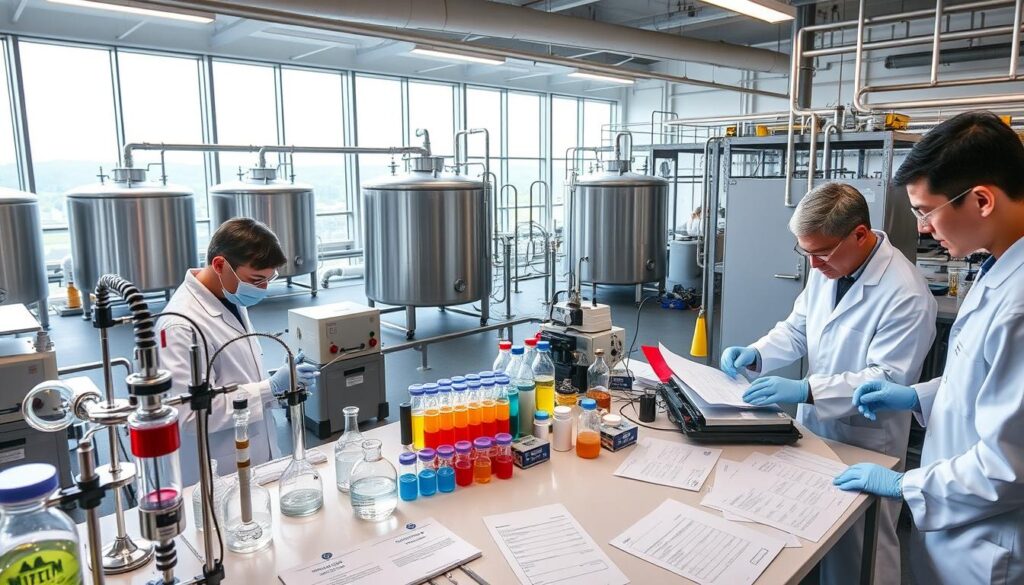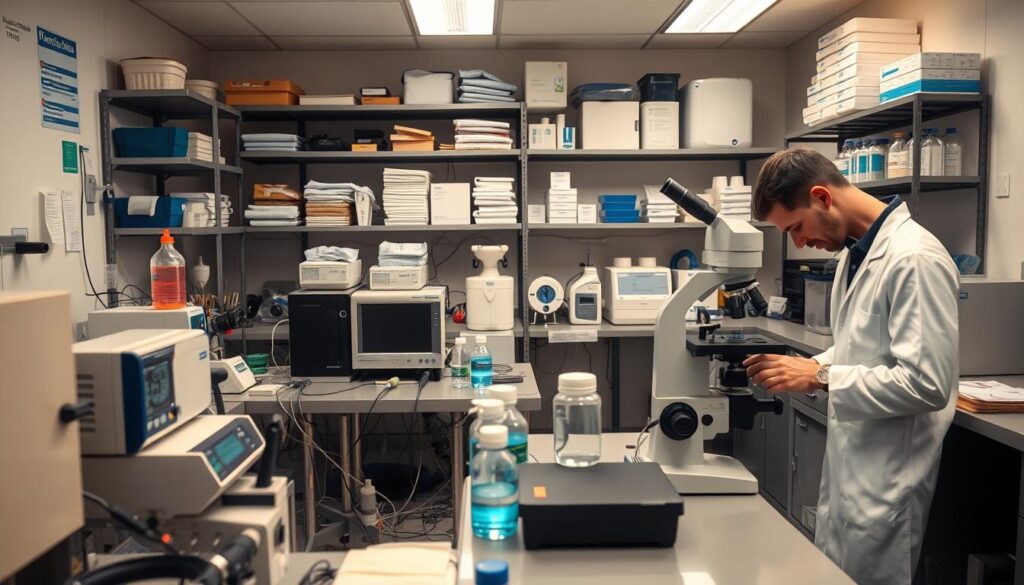Are you aware of the critical differences between managing wastewater treatment daily and meeting regulatory requirements? Understanding the distinction between these two approaches is vital for effective wastewater management.
Efficient wastewater treatment relies on a nuanced understanding of both process control and regulatory lab testing. While they may seem similar, these two aspects serve distinct purposes in ensuring wastewater is treated effectively and safely.
Key Takeaways
- Understanding the differences between process control and regulatory lab testing is crucial.
- Process control focuses on the daily management of wastewater treatment.
- Regulatory lab testing ensures compliance with environmental regulations.
- Both aspects are vital for effective and safe wastewater treatment.
- Combining process control and regulatory lab testing improves overall wastewater management.
The Dual Nature of Wastewater Laboratory Testing
Effective wastewater treatment relies heavily on laboratory testing, which fulfills two critical functions: process control and regulatory compliance. Wastewater treatment plants are complex systems that require precise management to remove contaminants and pollutants from wastewater before it is discharged into the environment or reused.
Overview of Wastewater Treatment Processes
Wastewater treatment involves several stages, including physical, chemical, and biological processes. These processes work together to remove various pollutants, such as suspended solids, organic matter, and nutrients. The treatment process typically includes preliminary treatment, primary treatment, secondary treatment, and sometimes tertiary treatment, depending on the requirements of the effluent.
The Two Testing Approaches: Control vs. Compliance
Laboratory testing in wastewater treatment serves two distinct purposes: process control testing and regulatory compliance testing. Process control testing is used to monitor and adjust the treatment process in real-time, ensuring that it operates efficiently and effectively. Regulatory compliance testing, on the other hand, is conducted to demonstrate that the treated effluent meets the standards set by regulatory agencies.
| Testing Approach | Purpose | Frequency |
|---|---|---|
| Process Control | Monitor and adjust treatment process | Daily/Continuous |
| Regulatory Compliance | Demonstrate compliance with regulations | Periodic (e.g., weekly, monthly) |
Understanding the dual nature of wastewater laboratory testing is crucial for optimizing treatment processes and ensuring compliance with regulatory requirements.
Process Control vs. Regulatory Lab Testing in Wastewater: Fundamental Differences
Understanding the distinctions between process control and regulatory lab testing is crucial for effective wastewater management. Wastewater treatment plants rely on laboratory testing to ensure that treatment processes are operating efficiently and that regulatory requirements are met.
Process Control Testing: Purpose and Applications
Process control testing is used to monitor and optimize wastewater treatment processes. This type of testing helps operators identify potential issues before they become major problems, allowing for adjustments to be made in real-time. By analyzing parameters such as pH, temperature, and dissolved oxygen, treatment plants can ensure that their processes are running smoothly.
Regulatory Compliance Testing: Legal Requirements and Standards
Regulatory compliance testing, on the other hand, is required by law to ensure that wastewater treatment plants are meeting specific standards for discharge. This type of testing involves analyzing wastewater samples for a range of parameters, including biochemical oxygen demand (BOD), total suspended solids (TSS), and fecal coliform. Treatment plants must comply with the regulations set forth by the Clean Water Act and NPDES permits.
Comparing Frequency, Parameters, and Methodologies
The frequency, parameters, and methodologies used for process control and regulatory compliance testing differ significantly. Process control testing is typically performed more frequently, often daily or weekly, to ensure that treatment processes are operating within optimal ranges. In contrast, regulatory compliance testing is usually performed less frequently, such as monthly or quarterly, but requires more rigorous sampling and analysis procedures.
By understanding the fundamental differences between process control and regulatory lab testing, wastewater treatment plants can optimize their treatment processes, ensure regulatory compliance, and protect the environment.
The Strategic Value of Process Control Testing
The importance of process control testing in wastewater treatment cannot be overstated, as it directly impacts treatment efficiency and compliance. By implementing rigorous testing protocols, wastewater treatment plants can optimize their operations, troubleshoot issues in real-time, and achieve significant cost savings.
Optimizing Treatment Efficiency and Performance
Process control testing enables operators to fine-tune treatment processes, ensuring that they operate at peak efficiency. This involves monitoring key parameters such as TSS (Total Suspended Solids), DO (Dissolved Oxygen), and MLSS (Mixed Liquor Suspended Solids). By maintaining optimal levels of these parameters, treatment plants can enhance their overall performance and reduce the risk of non-compliance.
Troubleshooting Operational Issues in Real-Time
One of the significant benefits of process control testing is its ability to facilitate real-time troubleshooting. By continuously monitoring treatment processes, operators can quickly identify and address operational issues before they escalate into major problems. This proactive approach helps to minimize downtime, reduce maintenance costs, and ensure consistent treatment quality.
- Identify issues promptly through continuous monitoring
- Address problems before they impact treatment quality
- Minimize downtime and reduce maintenance costs
Cost Savings Through Proactive Management
Effective process control testing leads to significant cost savings by enabling proactive management of wastewater treatment processes. By optimizing treatment efficiency, reducing energy consumption, and minimizing the need for costly repairs, treatment plants can lower their operational expenses. Additionally, by avoiding non-compliance fines and reducing the risk of environmental harm, plants can further reduce their costs and enhance their sustainability.
In conclusion, process control testing is a vital component of modern wastewater treatment, offering numerous strategic benefits that enhance treatment efficiency, troubleshooting, and cost savings. By leveraging advanced testing protocols and real-time monitoring, treatment plants can optimize their operations and achieve better outcomes.
Navigating the Regulatory Landscape for Wastewater Testing
The regulatory environment surrounding wastewater testing is multifaceted, involving federal, state, and local regulations. Wastewater treatment plants must comply with a myriad of standards and testing protocols to ensure environmental protection and public health.

Clean Water Act and NPDES Permit Requirements
The Clean Water Act (CWA) is the primary federal law governing water pollution in the United States. Under the CWA, the National Pollutant Discharge Elimination System (NPDES) permit program regulates discharges into navigable waters. NPDES permits set specific limits on pollutants and require regular monitoring and reporting. Compliance with these permits is crucial for avoiding enforcement actions.
NPDES permit requirements include detailed monitoring and reporting schedules, effluent limits, and special conditions tailored to the specific needs and impacts of the discharge. Treatment plants must adhere to these conditions to maintain compliance.
State-Level Regulations and Local Ordinances
In addition to federal regulations, state and local governments impose their own set of regulations and ordinances. These can be more stringent than federal standards and may address specific regional concerns. For example, a state might have additional requirements for testing certain pollutants or for discharges into sensitive water bodies.
State-level regulations can vary significantly, making it essential for wastewater treatment facilities to be aware of and comply with the specific regulations in their jurisdiction. This includes understanding any local ordinances that may affect their operations.
Consequences of Non-Compliance and Enforcement Actions
Failure to comply with regulatory requirements can result in significant consequences, including fines, legal action, and reputational damage. Regulatory agencies have various enforcement tools at their disposal, from warning letters and fines to criminal prosecution in severe cases.
The consequences of non-compliance underscore the importance of robust compliance programs, including regular training, internal monitoring, and prompt response to any compliance issues that arise. By prioritizing compliance, wastewater treatment facilities can avoid enforcement actions and contribute to environmental protection.
Essential Parameters and Tests for Process Control
Process control testing is a vital component of wastewater management, ensuring treatment processes operate within optimal ranges. Effective process control is crucial for maintaining the balance between treatment efficiency and regulatory compliance.
Daily Operational Tests: TSS, DO, and MLSS
Daily operational tests are fundamental to the smooth operation of wastewater treatment plants. Key parameters include:
- Total Suspended Solids (TSS): Measures the concentration of suspended solids in the wastewater.
- Dissolved Oxygen (DO): Essential for maintaining aerobic conditions in biological treatment processes.
- Mixed Liquor Suspended Solids (MLSS): Indicates the concentration of microorganisms in the aeration tank.
Biological Process Monitoring: F/M Ratio and SVI
Biological process monitoring is critical for optimizing the performance of biological treatment processes. Two key parameters are:
- Food-to-Microorganism (F/M) Ratio: This ratio helps in maintaining the balance between the food available to microorganisms and their concentration.
- Sludge Volume Index (SVI): SVI measures the settling characteristics of the sludge, indicating the health of the biological process.
Microscopic Examination Techniques
Microscopic examination is a valuable tool for assessing the health of the biological process. It involves examining the types and quantities of microorganisms present in the sludge.
Nutrient Removal Monitoring
Nutrient removal is a critical aspect of wastewater treatment, especially in plants that are required to remove nitrogen and phosphorus. Monitoring involves tracking the levels of these nutrients throughout the treatment process.
| Parameter | Description | Importance |
|---|---|---|
| TSS | Total Suspended Solids | Indicates the concentration of suspended solids |
| DO | Dissolved Oxygen | Essential for aerobic conditions |
| MLSS | Mixed Liquor Suspended Solids | Indicates microorganism concentration |
| F/M Ratio | Food-to-Microorganism Ratio | Balances food and microorganisms |
| SVI | Sludge Volume Index | Measures sludge settling characteristics |
Critical Compliance Parameters for Regulatory Reporting
Regulatory reporting for wastewater treatment involves several critical parameters that facilities must monitor and report on accurately. These parameters are essential for ensuring that wastewater treatment plants comply with environmental regulations and standards.
Primary Discharge Parameters: BOD, TSS, pH, and Fecal Coliform
Primary discharge parameters are crucial indicators of the quality of treated wastewater. BOD (Biochemical Oxygen Demand) and TSS (Total Suspended Solids) are key measures of the organic and inorganic content in the effluent. pH levels indicate the acidity or alkalinity of the discharge, while Fecal Coliform counts are critical for assessing the presence of harmful bacteria. Monitoring these parameters helps in maintaining the environmental integrity of receiving waters.
Toxicity Testing and Whole Effluent Testing (WET)
Toxicity testing, including Whole Effluent Testing (WET), is a critical component of regulatory compliance. WET tests assess the overall toxicity of the treated effluent on living organisms, providing a comprehensive measure of its potential environmental impact. This testing is vital for identifying potential hazards and ensuring that the treated wastewater does not harm aquatic life.
Metals, Priority Pollutants, and Emerging Contaminants
In addition to primary discharge parameters, wastewater treatment facilities must also monitor for metals, priority pollutants, and emerging contaminants. These substances can have significant environmental and health impacts, even at low concentrations. Regular monitoring and reporting of these contaminants are essential for maintaining compliance with regulatory standards and protecting public health and the environment.
By focusing on these critical compliance parameters, wastewater treatment facilities can ensure they meet regulatory requirements, minimize environmental impact, and contribute to a healthier ecosystem.
Quality Assurance and Control in Wastewater Testing
Ensuring the accuracy and reliability of wastewater testing is crucial for both process control and regulatory compliance. As we’ve discussed in previous sections, wastewater treatment plants must adhere to stringent regulations while optimizing their treatment processes. Quality assurance and control (QA/QC) play a vital role in achieving these objectives.
QA/QC Protocols for Regulatory Compliance
To meet regulatory requirements, wastewater treatment plants must implement robust QA/QC protocols. This includes regular calibration and maintenance of laboratory equipment, as well as the use of certified reference materials and standards. “The quality of the data generated by a laboratory is directly related to the quality of the QA/QC protocols in place,” as stated by the Environmental Protection Agency (EPA).
“The quality of the data generated by a laboratory is directly related to the quality of the QA/QC protocols in place.”
Calibration and Standardization Procedures
Calibration and standardization are critical components of QA/QC in wastewater testing. Laboratories must ensure that their equipment is properly calibrated and that analysts are trained in standardized methods. This involves regular training and proficiency testing to maintain high levels of competence.
Documentation and Chain of Custody Requirements
Proper documentation and chain of custody are essential for maintaining the integrity of wastewater samples and test results. This includes detailed record-keeping of sample collection, handling, and analysis, as well as secure storage of data and samples. By maintaining a robust chain of custody, laboratories can ensure the reliability and defensibility of their results.
In conclusion, QA/QC is a critical aspect of wastewater testing, ensuring that results are accurate, reliable, and compliant with regulatory requirements. By implementing robust QA/QC protocols, calibration procedures, and documentation practices, wastewater treatment plants can optimize their operations and maintain regulatory compliance.
Common Challenges and Practical Solutions in Wastewater Testing
Wastewater treatment plants encounter various difficulties in lab testing, necessitating practical solutions. Laboratory testing is a critical component of wastewater treatment, playing a vital role in both process control and regulatory compliance.

Staffing and Resource Limitations
One of the significant challenges faced by wastewater treatment plants is staffing and resource limitations. Laboratories often struggle with inadequate staffing, lack of specialized training, and insufficient resources, which can compromise the accuracy and reliability of test results.
To address these issues, facilities can invest in ongoing training for laboratory personnel and consider hiring experienced staff. Additionally, leveraging technology such as automated sampling and testing systems can help optimize resource utilization.
Managing Sampling Variability and Interference
Sampling variability and interference are other critical challenges in wastewater testing. Variability in sampling can lead to inaccurate representations of the wastewater quality, while interference can affect the precision of analytical results.
Implementing robust sampling protocols and using appropriate sampling equipment can minimize variability. Laboratories can also employ techniques such as matrix spike recoveries to assess and mitigate interference.
Balancing Cost Constraints with Testing Needs
Wastewater treatment plants must balance the need for comprehensive testing with cost constraints. The cost of laboratory testing can be significant, and facilities must prioritize their testing needs while ensuring compliance with regulatory requirements.
Outsourcing vs. In-House Testing Considerations
One strategy for managing costs is to weigh the pros and cons of outsourcing laboratory testing versus maintaining in-house capabilities. Outsourcing can provide access to specialized expertise and equipment, while in-house testing offers greater control over the testing process.
| Consideration | In-House Testing | Outsourced Testing |
|---|---|---|
| Cost | Initial equipment investment, ongoing labor costs | Per-test costs, potentially lower overall |
| Control | Greater control over testing process and timing | Less control, dependent on external laboratory |
| Expertise | Requires in-house expertise and training | Access to specialized external expertise |
By understanding these challenges and implementing practical solutions, wastewater treatment plants can enhance their laboratory testing capabilities, ensuring both effective process control and regulatory compliance.
Technology and Innovation in Wastewater Analysis
Technology is playing a crucial role in enhancing wastewater treatment processes, making them more efficient and compliant with regulations. The integration of advanced technologies is transforming the way treatment plants operate, monitor, and control wastewater treatment.
Online Monitoring Systems and Process Automation
Online monitoring systems are revolutionizing wastewater treatment by providing real-time data on various parameters such as pH, temperature, and dissolved oxygen. This enables operators to make timely adjustments, optimizing treatment efficiency. As noted by industry experts, “Real-time monitoring is key to maintaining optimal wastewater treatment processes.”
“The use of real-time data allows for immediate corrective actions, significantly reducing the risk of non-compliance.”
Advanced Laboratory Equipment and Methodologies
Laboratories are adopting advanced equipment and methodologies to improve the accuracy and speed of wastewater analysis. Techniques such as spectroscopy and chromatography are becoming more prevalent, enabling the detection of a wider range of contaminants. These advancements are crucial for monitoring wastewater treatment processes and ensuring compliance with regulatory standards.
Data Management and Reporting Software Solutions
Effective data management is critical in wastewater treatment. Modern software solutions facilitate the collection, analysis, and reporting of data, making it easier to track performance and comply with regulatory requirements. These systems can automate reporting, reduce errors, and provide insights into treatment efficiency, thereby supporting wastewater treatment optimization efforts.
By embracing these technological innovations, wastewater treatment plants can enhance their operational efficiency, reduce costs, and improve their overall environmental performance.
Conclusion: Achieving Balance Between Process Control and Regulatory Compliance
Effective wastewater management hinges on striking a balance between process control and regulatory compliance testing. By understanding the distinct roles of these two testing approaches, treatment plants can optimize their operations while adhering to legal requirements.
Process control testing enables real-time monitoring and adjustments, ensuring treatment efficiency and cost savings. Meanwhile, regulatory compliance testing guarantees adherence to standards set by the Clean Water Act and NPDES permits, safeguarding environmental and public health.
In the context of process control vs. regulatory lab testing in wastewater, it’s clear that both are essential components of a comprehensive wastewater management strategy. By integrating these approaches and leveraging advancements in wastewater compliance testing, treatment facilities can enhance their overall performance and minimize environmental impact.
Ultimately, a balanced approach to wastewater testing not only ensures regulatory compliance but also contributes to a more sustainable and environmentally conscious treatment process.
